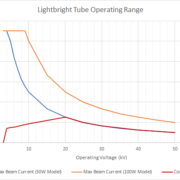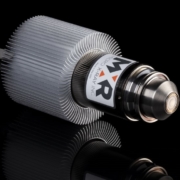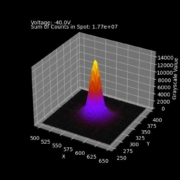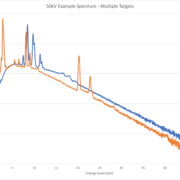Use Case Deep Dives: X-ray Thickness Gauging
What is X-ray Thickness Gauging?
X-ray thickness gauging is pivotal in online control applications, providing real-time measurements to maintain product quality and consistency. This post delves into the fundamental physics underpinning this technology, primarily the Beer-Lambert Law, which relates to the attenuation of X-rays passing through a material to its thickness. Understanding this principle is essential for effectively utilizing and optimizing X-ray thickness measurement systems in various industrial processes.
Understanding the Beer-Lambert Law
The Beer-Lambert law relates to the attenuation of photons through a material. In the case of X-ray thickness gauging, this relationship can be used to determine the thickness of a known material by shining some fixed quantity of X-ray photons through the material through a detector. Some of these X-rays will be absorbed in the material, and the rest will hit the detector. By counting these “missing” X-rays, the thickness of the material can be accurately determined.
The Beer-Lambert law is typically expressed as:
\({\large I = I_0 e^{-\mu x}}\)Where
\(\begin{align*}I &\rightarrow \text{Observed intensity} \\
I_0 &\rightarrow \text{Initial intensity} \\
\mu &\rightarrow \text{Linear attenuation coefficient of material} \\
x &\rightarrow \text{Material thickness}
\end{align*}\)
Setting up the Equation: Arranging for x
Because we’re interested in the thickness of the material, we can rearrange the equation to solve for the thickness as follows:
\({\large x = \frac{\ln\left(\frac{I}{I_0}\right)}{\mu}}\)
Setting up the Equation: Defining the Constants
In the equation above, the initial intensity \(I_0\) and attenuation coefficient \(\mu\) are constants.
The initial intensity can be defined as the number of X-ray photons read by the detector with no material present. Complex variables related to the X-ray tube itself, the geometry of the measurement system, and the efficiency of the detector all contribute to the initial intensity of the measurement system. For this reason, \(I_0\) is generally measured in situ in the final machines. Also, the tube and detector efficiencies can change slightly over time, so periodic recalibration of the initial intensity is recommended.
The mass attenuation coefficient, \(\mu\), can also be thought of as a constant for a given material and measurement system. This value varies with material composition and X-ray energy, necessitating referencing databases such as the NIST X-Ray Mass Attenuation Coefficients database. For practical applications, especially with varying X-ray photon energies such as in bremsstrahlung radiation produced by an X-ray tube, integrating these tables over the energy spectrum is essential. This integration acknowledges the range of X-ray energies produced, ensuring the calculated thickness accounts for the entire X-ray spectrum. Again, because of the complexities of these calculations, in practice these numbers are often empirically defined by using coupons of the materials under test at calibrated thicknesses to calculate the mass attenuation coefficient. This can be achieved with a simple rearranging of the now-familiar formula:
\({\large \mu = \frac{\ln\left(\frac{I}{I_0}\right)}{x}}\)
By running the system with no sample, and with several samples of known thickness, we can empirically determine both the initial intensity of our measurement system, as well as the mass attenuation value for the material we’ll be measuring.
Solving for x: Calculating the Thickness
At this point in the process, we have our initial intensity, \(I_0\), and our mass attenuation, \(\mu\), defined for the material we’re testing. All that’s left now is to shine the X-rays through the sample, measure the X-rays at the detector, \(I\), plug in the variables, and solve for \(x\).
\({\large x = \frac{\ln\left(\frac{I}{I_0}\right)}{\mu}}\)Calculating the thickness in real-time enables truly closed-loop process control in thin film production environments. The thickness can be fed back in real time to the control systems overseeing the line speed to either slow down or speed up the line to maintain the desired thickness within the required tolerance.
Why MXR’s X-Ray Tubes Excel in Thickness Measurement
MXR’s X-ray tubes stand out in thickness measurement applications due to their highly stable X-ray flux, ultra-low leakage current, and highly repeatable process. These features ensure that the initial intensity remains consistent, a crucial factor for accurate applications of the Beer-Lambert Law in real-time control systems.
Stability in X-ray flux minimizes the variability in measurements, leading to high precision, while the low leakage current reduces noise, further enhancing measurement accuracy. This combination makes MXR’s tubes exceptionally reliable for precision thickness gauging applications.
At MXR, we understand the critical importance of precise thickness measurements in maintaining product quality. Our X-ray tubes are engineered for exceptional stability and low leakage current, ensuring adherence to the Beer-Lambert Law and enabling high-precision gauging. Transform your measurement process with MXR’s reliable technology. Contact us today to find out how our X-ray solutions can refine your quality control and enhance your operational accuracy.
